SB 431542
SB 431542 is a small molecule that forms a complex with TβRI Kinase domain. The structure of theTβRI Kinase domain-SB 431542 complex is diagrammatically shown in Figure 1 while the close interactions within this complex are diagrammatically illustrated in Figure 2.
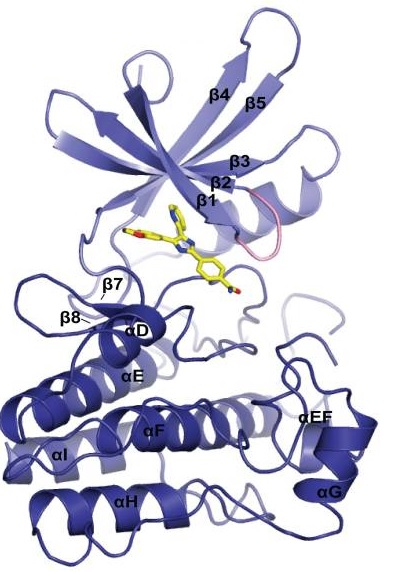
Figure 1 The Structure of TβRI Kinase domain-SB 431542 Complex: The SB 431542 molecule is shown in Yellow that resides in the ATP binding cleft of the TβRI Kinase domain, while TβRI Kinase domain is shown in Blue.
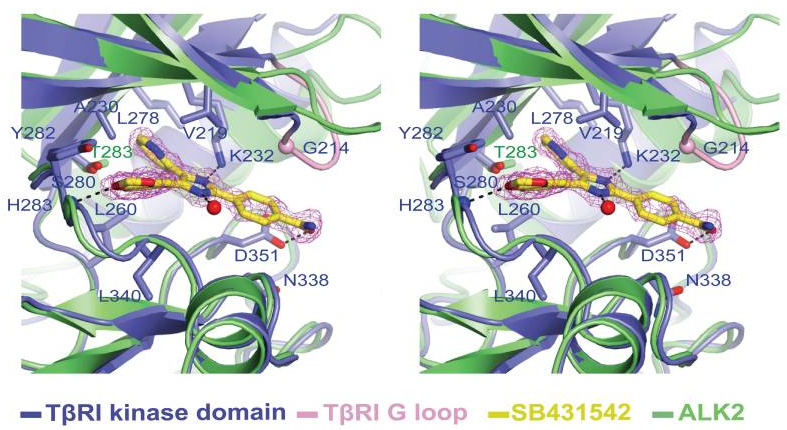
Figure 2 Zoomed in view of the SB 431542 molecule in close association with the TβRI Kinase domain. All the color legends are indicated in the figure. Here, the amino acid residues which are in close proximity of the SB 431542 molecule are labelled, while dotted lines represent the hydrogen bonds between them. Moreover, a sphere in red represents a water molecule.
It specifically inhibits receptor proteins, i.e., activin receptor – like kinases which includes ALK4, ALK5, and ALK7, which are the type I receptors belonging to the superfamily of Transforming Growth Factor-B (TGF-B). Transforming Growth Factor-B (TGF-B) in small amount, has the tumor suppressing effects. But, the Transforming Growth Factor-B (TGF-B) in large amount, has the tumor promoting effects after interacting with the associated receptor kinase through the initiation and progression of the specific signaling pathway. Reduced response of the body’s immune system, stimulated formation of the connective tissue and new blood vessels, and all those phenomena that eventually leads to metastasis, all are the major landmarks of this tumor promoting effect. All of these effects can be effectively blocked if the associated receptor protein expressed on the cell surface is somehow prevented from interacting with the Transforming Growth Factor-B (TGF-B). The tumor promoting nature and not the tumor suppressing nature of the Transforming Growth Factor-B (TGF-B) must be targeted for the effective cancer management.
Besides promoting and suppressing the tumors, Transforming Growth Factor-B (TGF-B) also regulates a broad spectrum of the biological functions, for example, proliferation and differentiation of the cells, formation of extracellular matrix and the process of programmed cellular death, i.e., apoptosis. Transforming Growth Factor-B (TGF-B) plays so many biological roles due to the fact that it forms a complex between the serine –threonine kinase receptors, i.e., type I and type II, which is oligomeric in nature. Transforming Growth Factor-B (TGF-B) first binds to the type II serine –threonine kinase receptor (TbRII), simultaneously it stabilizes the complex with the type I serine –threonine kinase receptor (TbRI) which is of heteromeric nature. This leads to the activation of the type I serine –threonine kinase receptor (TbRI) via its transphosphorylation. This activated TbRI further activates Receptor-regulated Smads (R-Smad) via its phosphorylation at two serine residual positions at the C-terminus. This activated R-Smads then form complex with Smad4, which is of heteromeric nature. This heteromeric complex is then translocated to the cell nucleus, where it regulates the transcription of TGF-b target genes. These effects and their inhibition are diagrammatically depicted in Figure 3.
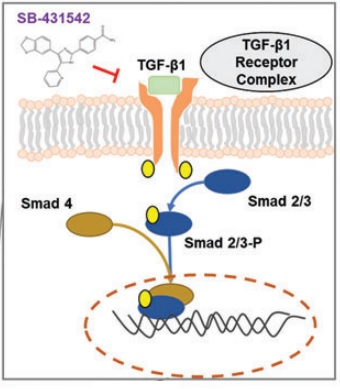
Figure 3 Effects of Transforming Growth Factor-B (TGF-B) and its inhibition by SB 431542
Apart from these signaling pathways, Transforming Growth Factor-B (TGF-B) can also lead to the induction of several other signaling pathways, namely, p38MAPK, ERK, PI3K, JNK, or Rho etc. all of the them promote the tumor growth. However, these signaling pathways can be either dependent on the Smads or independent of them. For the inhibition of the complex roles of Transforming Growth Factor-B (TGF-B), macromolecules like pan-TGF-b neutralizing antibodies and TbRII-Fc fusion protein didn’t show convincing results. But small molecules like SB 431542 have the potential to be clinically, i.e., therapeutically used owing to its specific action and greater efficacy.
Transforming Growth Factor-B (TGF-B) cause the tumors in the epithelial cells to attain metastasis. The salient features of the metastasis include changed cellular plasticity, in which the phenotype of the cell is changed without any changes to the genotype; cell to cell contacts is lost, cell migration is increased; Extracellular matrix ECM is degraded. While, the most prominent feature is the Epithelial to Mesenchymal Transition EMT which gives the tumor cells an overall spindle morphology with an increased level of motility as the tight and adherent junctions are lost. This phenomenon is scientifically shown in a research study, the results are diagrammatically illustrated in Figure 4. Moreover, in the same figure, it has also been shown that SB 431542 has effectively nullified these effects by preventing Epithelial to Mesenchymal Transition EMT.
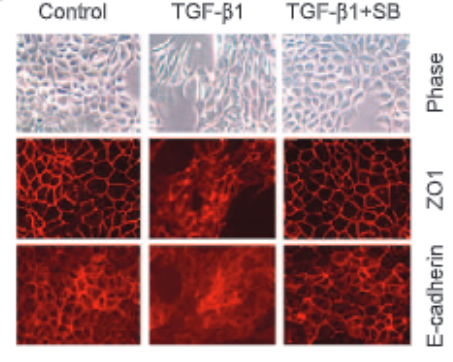
Figure 4 The Effect of TGF-b1 alone, and of SB-431542 & TGF-b1 on the Cell Morphology of the mouse mammary epithelial cells (NMuMG). As compared to the experimental control group, TGF-b1 cause a morphological change in NMuMG; the morphology has been changed to the spindle-like. On the other hand, those cells which are treated with SB-431542 & TGF-b1, the original cell morphology, i.e., cuboid is maintained.
Transforming Growth Factor-B (TGF-B) triggers the process of chemotaxis that causes the migration of tumor cells. Although, it is not caused in all the cancer cell lines. In a research based scientific study, the chemotactically induced cell migration as well as cell invasion in the lung adenocarcinoma cells A549 via the activity of TGF-b1 are quantified. Interesting, both has been increased three times when treated with TGF-b1. Moreover, both cell migration as well as cell invasion are statistically significantly reduced when treated with SB 431542. Furthermore, it happened in a dose dependent manner; as the SB 431542 concentration increases, lesser number of A549 cells are able to migrate as well as invade through the respective membranes. These convincing results are graphically shown in Figure 5.
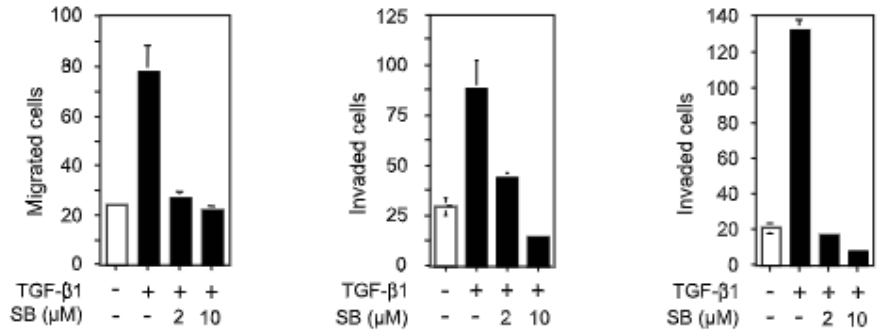
Figure 5 The Effect of TGF-b1 alone, and of SB-431542 & TGF-b1 on the Cell Migration and Invasion when observed in the human lung carcinoma cell line A549 1. Through Polycarbonate Membrane (in left bar graph) 2. Through Collagen Membrane (in the middle bar graph) 3. Through Matrigel Membrane (in the right bar graph). Here, the number of cells either migrated or invaded are plotted against TGF-b1 alone, and of SB-431542 & TGF-b1 treatments in different graphs. White bar of the graph is the experimental control
The expression of Vascular endothelial growth factor (VEGF) is upregulated in many human tumors. Moreover, the Transforming Growth Factor-B (TGF-B) treatment further enhance the upregulation of the Vascular endothelial growth factor (VEGF) in the cell lines, i.e., A549 and HT29. Furthermore, the expression of the Vascular endothelial growth factor (VEGF) is statistically significantly reduced by treating these cell lines with SB 431542. These results are graphically shown in Figure 6.
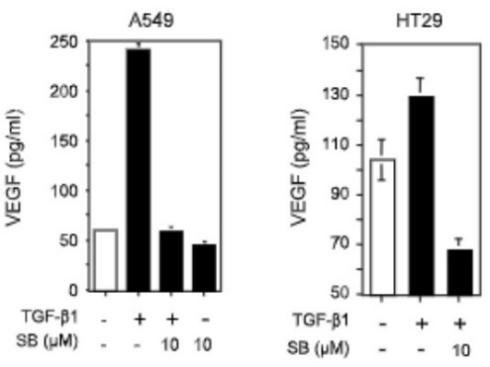
Figure 6 The Effect of TGF-b1 alone, and of SB-431542 & TGF-b1 on the expression of the Vascular endothelial growth factor (VEGF) in the Cell lines, i.e., A549 and HT29
Fibrosis induced by the TGF-b1 is the major landmark of the Arthrofibrosis. It is also characterized by the abnormal differentiation of the Fibroblast-like synoviocytes FLS, followed by the abnormal accumulation of the Extracellular Matrix ECM. Both of these sequential processes are effectively inhibited by the SB-431542 treatment as shown in Figure 7.

Figure 7 SB-431542 inhibits the proliferation and differentiation of the Fibroblast-like synoviocytes FLS













Commentaires